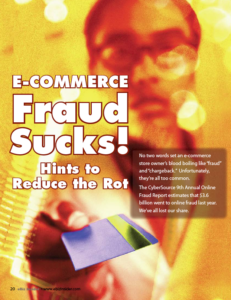
From the March 2008 issue of eBiz Insider magazine. Download the complete issue as a PDF by clicking here.
The rate of fraud associated with international orders is over two-and-one-half times that of domestic orders. Merchants also reject international orders at a rate of two-and-one-half times higher than domestic orders.
– CyberSource
No two words set an e-commerce store owner’s blood boiling like “fraud” and “chargeback.” Unfortunately, they’re all too common.
The CyberSource 9th Annual Online Fraud Report estimates that $3.6 billion went to online fraud last year. We’ve all lost our share.
Fraud will continue to grow along with e-commerce unless we stop bad orders before they hit the package car. The question is, how?
Be Wary of Foreign Orders
Merchants surveyed by CyberSource said “the rate of fraud associated with international orders is over two-and-one-half times that of domestic orders. Merchants also reject international orders at a rate of two-and-one-half times higher than domestic orders.”
When I ran our former pet supply division, we had a many international orders and were occasionally burned. We developed a straightforward no-exception international policy:
- International customers must fax a copy of the credit card (front and back) along with a signed copy of the order
- The issuing card bank must verify billing information
- No orders to third-world or developing countries
- Absolutely no orders to Nigeria, the fraud capital of the world
We immediately caught numerous orders before the card was run when customers could not provide information. After we established a relationship with the international customer (at least 2 orders without a problem) we noted their account and streamlined the process.
Shipping to international destinations teaches you which country’s postal systems are corrupt and whose agents steal packages rather than deliver them. You learn which countries let you bypass customs if you mark the package as containing “religious articles.” Sadly, you’ll also learn which countries either hold packages for months or don’t deliver them at all.
Beware of Warning Signs
International fraud may be most prevalent, but we have plenty here at home, too.
The first warning of a fraudulent order is a package with a “ship to” address in a different state than the “bill to” address and is being shipped next-day air. In this case the “perp” will have stolen a credit card. He or she will get the billing address and take delivery at a vacant house, a house known to be empty at a specific time, or an empty lot. Because it’s next day air, the perp stakes out the location, meets the delivery, signs and disappears with the package. Trust me, it happens!
We immediately flagged orders like these and had a CSR contact the credit card’s fraud department to verify if the customer had a valid shipping address on file and if fraudulent activity had previously occurred on the card. We matched the shipping name address to the house registration. Next, we would run the card and match the AVS. Finally, we called the customer for verbal confirmation before releasing the information. It’s not always 100%, but it reduced fraud.
Policies and Procedures Provide Protection
- Always, always, always, use address verification (AVS) with your credit card processor. AVS compares house numbers and zip codes of what you’re sending and what the customers have on file with their card company. If it doesn’t match, proceed with caution. AVS is generally available only for US cardholders in Canada and the UK.
- You are considered a card-not-present merchant and must obtain a card verification number (CVN, CVV2, CVC2, or CID). These three- or four-digit numbers verify that the card is in the possession of the card holder. This verifies, but does not guarantee the card isn’t stolen.
What if I’m a Victim of Fraud?
Usually, you’re out of luck. When a person who had a card used in a fraudulent transaction files a chargeback with the bank, you’re notified and allowed to file a response. Review the documentation with the chargeback notification and file the response even if it appears like fraud. Have it on file. Unfortunately, CyberSource reports that only 40% of chargebacks filed are won. If it’s a clear case of fraud, you won’t win a chargeback. File the paperwork, provide the transaction information and cross your fingers.
Fraud is real and some scams will get through. Still, having policies in place and being diligent are a good start.
 |
 |
